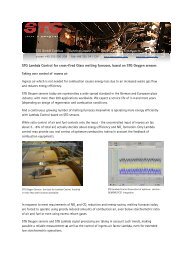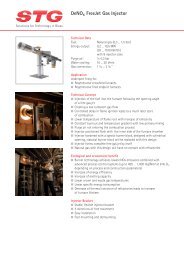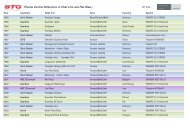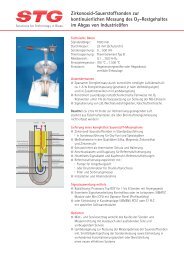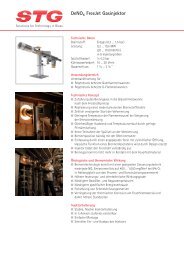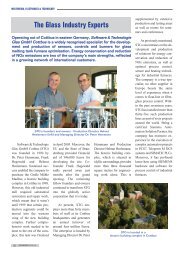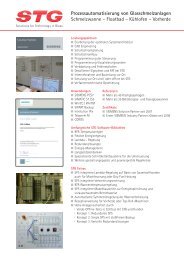Software&Technologie Glas GmbH Cottbus Tel.: (+49) - STG ...
Software&Technologie Glas GmbH Cottbus Tel.: (+49) - STG ...
Software&Technologie Glas GmbH Cottbus Tel.: (+49) - STG ...
You also want an ePaper? Increase the reach of your titles
YUMPU automatically turns print PDFs into web optimized ePapers that Google loves.
Software&<strong>Technologie</strong> <strong>Glas</strong> <strong>GmbH</strong> <strong>Cottbus</strong> <strong>Tel</strong>.: (<strong>+49</strong>) 355-590 200<br />
Bahnhofstraße 76 Fax: (<strong>+49</strong>) 355-541 124<br />
D-03058 Kiekebusch e-mail: <strong>STG</strong>@<strong>STG</strong>-<strong>Cottbus</strong>.de<br />
Germany www.<strong>STG</strong>-<strong>Cottbus</strong>.de<br />
EsDeNOx: The <strong>STG</strong> Energy saving Technology to reduce NOx Emission in conventional<br />
regenerative glass tank furnaces<br />
Using the know-how and the tools of energy saving in the heating of glass tank furnaces,<br />
<strong>STG</strong> <strong>GmbH</strong> <strong>Cottbus</strong> has developed a DeNOx technology,<br />
• which reaches a 50…70% reduction in NOx-emission, down to 350…800 mg/Nm3 of<br />
NOx,<br />
• which is accompanied by 5% and more of energy saving plus increased melting capacity.<br />
The EsDeNOx-Technology is based on a remarkable increase of energy transfer from the<br />
flames to batch and glass directly. So the basic elements of EsDeNOx Technology are:<br />
- <strong>STG</strong> DeNOx Natural Gas Burner or <strong>STG</strong> DeNOx Heavy Fuel Oil Burner<br />
- <strong>STG</strong> Lambda Control based on Zircon-Dioxide Lambda sensors<br />
- OMC Optical Melting Control, computerized furnace TV picture processing<br />
EsDeNOx Technology is available for conventional regenerative glass tank furnaces, end port<br />
or cross fired furnaces, using natural gas or heavy fuel oil or mix of them, having<br />
burners/injectors in underport- or in sideport-position.<br />
Lambda Control based on Zirkondioxide Lambda Sensors<br />
The Lambda Control system has to organize the correct supply of total combustion air, to<br />
make sure, that the excess of oxygen over the stochiometric ratio to the fuel will be optimum<br />
low and stable at any time and at any burner, port by port, firing side by firing side. Only the<br />
cooperation of this both elements of DeNOx technology enables to the target results of NOx<br />
reduction and energy saving.<br />
Lambda control – that means:<br />
- Measuring flue gas composition downstream just after furnace chamber and<br />
monitoring the actual figure of uncontrolled parasite air infiltration<br />
- Based on that mimize air infiltration, which is allways reason of energy losses and<br />
extended NO formation<br />
- Compensate changing parasite air infiltration by modified combustion air input. This<br />
has to be done in the way of predictive control due to long response time of such a<br />
control loop<br />
Since more than 10 years <strong>STG</strong> has a growing experience in production, installation and<br />
maintenance of Zircondioxide Lambda Sensors, which are used now in about a hundred<br />
furnaces in europe and worldwidely. Service life of the sensors was extended step by step<br />
using long time experience of sensor maintenance to now up to 3..4 years service.
<strong>STG</strong> DeNOx Heavy Fuel Oil Burner<br />
Growing requirements for NOx-reduction in the flue gases of glass tank furnaces lead <strong>STG</strong> to<br />
develop a new generation of DeNOx oil-burners, which produce a narrow-shaped oil-dropdistribution<br />
and avoide the very small oil drops as well as the very big oil drops.<br />
Main oil burner data are:<br />
- Capacity : size 1 260…3000 kW<br />
size 2 650…5000 kW<br />
- Heavy fuel oil : 75…130 °C , 6 bar<br />
- Atomizing air or gas : 0,05…0,25 Nm³/kg, 0,2…2,5 bar<br />
The special DeNOx and Energy saving characteristics of this burner are based mainly on the<br />
narrow-shaped distribution of oil-drop-sizes.<br />
<strong>STG</strong> DeNOx FreeJet gas burnesr produce lower NOx than heavy oil burners<br />
The technological target is the same as for oil: avoid rapid temperature increase at flame root<br />
and increase energy release in order to reach low flame temperature.<br />
<strong>STG</strong> FreeJet gas burner forms a narrow funnel, just following the opening angle of a free gas<br />
jet up to the open furnace chamber. This low turbulence gas flow is mixing with combustion<br />
air and starting combustion much later than conventional burner type, giving the gas enough<br />
time and space for self-carburization, to form small carbon particles, which increase the<br />
emissivity of the gas flame and let the flame temperature drop down for more than 50 K.<br />
Main gas burner data are:<br />
- Capacity : size 1 300…1800 kW<br />
size 2 800…5000 kW<br />
- Gas pressure : 0,9…1,2 bar<br />
- Cooling air : 50 Nm³/h, 0,3 bar<br />
OMC - Optical Melting Control: stable glass quality by stable glass temperature<br />
Keeping stable glass qualtity or even to improve it is a basic principle of any energy saving<br />
and NOx reducing technology.<br />
New tools for direct and continous control of melting and refining process of glass in the<br />
furnace are an indispensable component of successful EsDeNOx Technology.<br />
OMC – Optical Melting Control uses the standard TV signal of a furnace camera, directed on<br />
batch melting area of the furnace.<br />
The melting zone of furnace represents the user-defined area of interest. Inside the melting<br />
zone each pixel is identified by digital filter to be batch or molten glass. So computerized<br />
picture processing during reversal at no-fire-situation provides the percentage of batch<br />
covered area, different for left and right firing side, and the speed of melting alongside<br />
furnace length-axis – which can be understood as a melting gradient .<br />
Percentage of batch covered area and melting gradient may be used as an indicator not only<br />
for energy supply to the melting area but as an indicator for stable recirculation glass flow and<br />
stable hot spot situation too. So furnace TV picture processing helps to keep optimum energy<br />
transfer to melting area and optimum glass quality conditions.<br />
2




